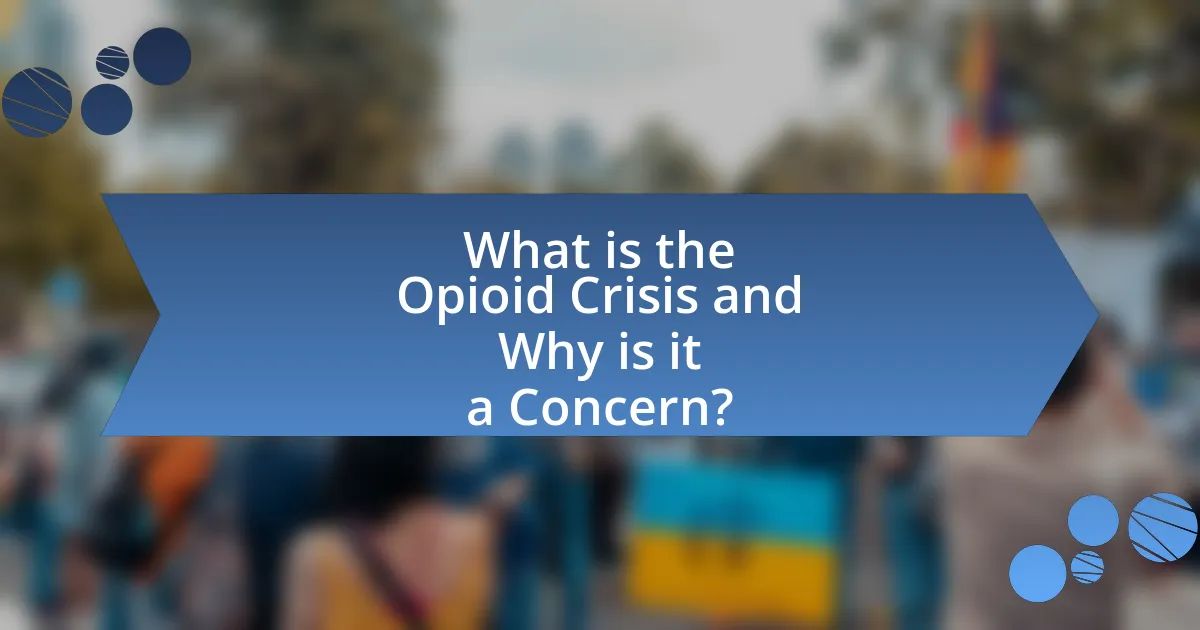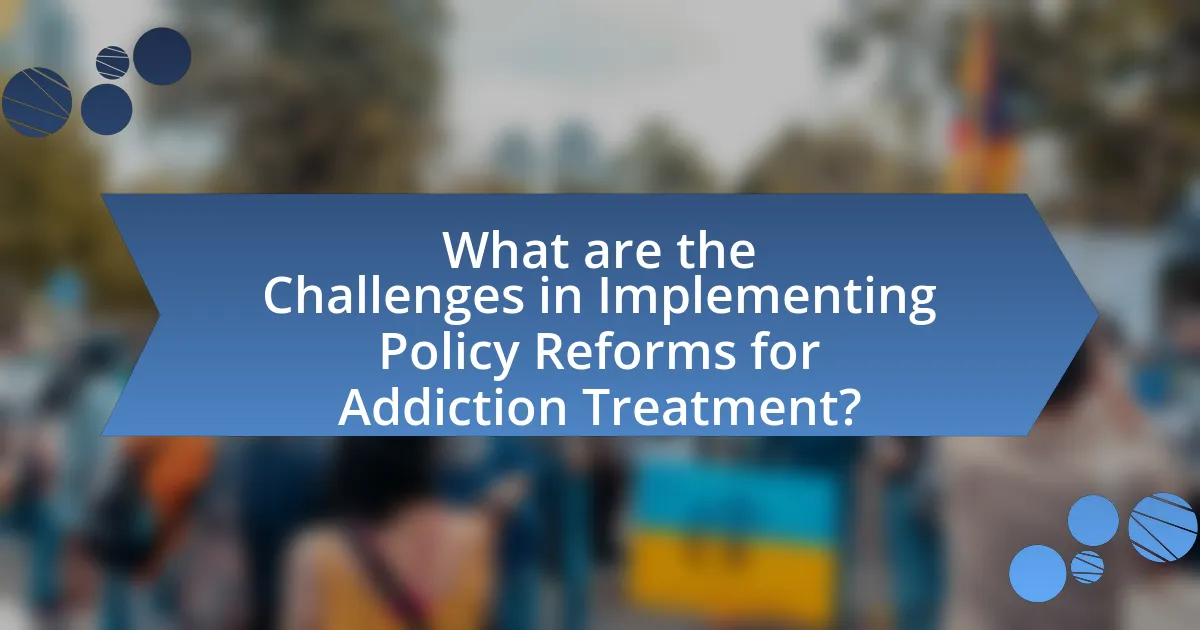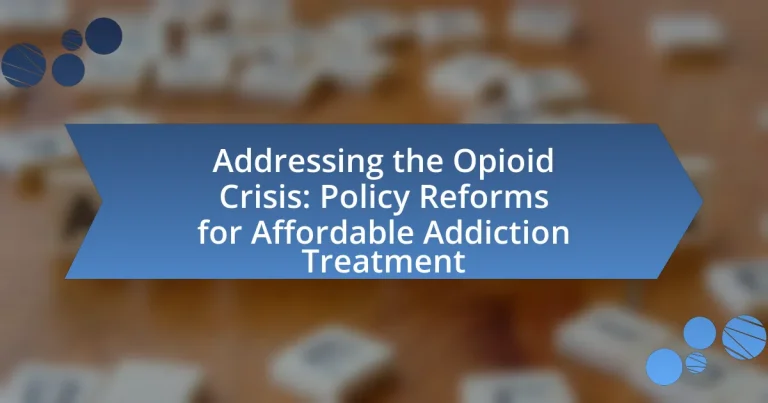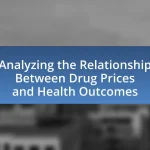The Opioid Crisis represents a significant public health emergency marked by the widespread misuse of opioid drugs, resulting in addiction and overdose deaths. This article examines the historical development of the crisis, highlighting the role of over-prescription and aggressive pharmaceutical marketing. Key statistics reveal the extensive impact of opioid addiction on individuals and the economy, with millions affected annually and substantial financial burdens on society. The article emphasizes the urgent need for comprehensive policy reforms to enhance access to affordable addiction treatment, including legislative measures, community engagement, and successful models from other regions. It also addresses the challenges in implementing these reforms, such as stigma and funding limitations, while outlining best practices for ensuring effective treatment options.

What is the Opioid Crisis and Why is it a Concern?
The Opioid Crisis is a public health emergency characterized by a significant increase in the misuse of prescription and non-prescription opioid drugs, leading to widespread addiction, overdose deaths, and societal impacts. This crisis is a concern because, according to the Centers for Disease Control and Prevention (CDC), over 564,000 people died from opioid overdoses between 1999 and 2020, highlighting the urgent need for effective policy reforms and affordable addiction treatment options to address the escalating health crisis and its ramifications on communities and healthcare systems.
How did the Opioid Crisis develop over time?
The Opioid Crisis developed over time primarily due to the over-prescription of opioid medications, which began in the late 1990s. Pharmaceutical companies aggressively marketed opioids as safe and non-addictive, leading to widespread use among patients for pain management. By 2010, the increase in prescription rates contributed to a surge in addiction and overdose deaths, prompting a shift towards illicit opioids like heroin and fentanyl. According to the Centers for Disease Control and Prevention (CDC), opioid overdose deaths quadrupled from 1999 to 2019, highlighting the escalating severity of the crisis. This progression illustrates how initial medical practices and marketing strategies laid the groundwork for a public health emergency that continues to evolve.
What historical factors contributed to the rise of opioid addiction?
The rise of opioid addiction can be attributed to several historical factors, including the over-prescription of opioids in the late 20th century and the pharmaceutical industry’s aggressive marketing strategies. In the 1990s, pharmaceutical companies promoted opioids as safe and non-addictive, leading to widespread prescribing by healthcare providers. This resulted in a dramatic increase in opioid prescriptions, with the U.S. prescribing rates rising from 76 million in 1991 to 207 million in 2013. Additionally, the introduction of OxyContin in 1996, marketed as a long-lasting pain relief solution, significantly contributed to addiction rates, as it was often misused and led to dependency. These factors collectively created an environment where opioid misuse became prevalent, setting the stage for the current addiction crisis.
How have prescription practices influenced the crisis?
Prescription practices have significantly influenced the opioid crisis by contributing to the over-prescription of opioid medications. Research indicates that between 1991 and 2011, the amount of prescribed opioids in the United States quadrupled, leading to increased availability and misuse. This surge in prescriptions has been linked to a rise in addiction rates, with the National Institute on Drug Abuse reporting that nearly 21-29% of patients prescribed opioids for chronic pain misuse them. Furthermore, the Centers for Disease Control and Prevention noted that over 70% of drug overdose deaths in 2019 involved an opioid, underscoring the direct correlation between prescription practices and the escalation of the crisis.
What are the key statistics surrounding the Opioid Crisis?
The Opioid Crisis has resulted in over 500,000 deaths in the United States from 1999 to 2019, according to the Centers for Disease Control and Prevention (CDC). In 2021 alone, there were approximately 80,000 opioid-related overdose deaths, marking a significant increase from previous years. Furthermore, the National Institute on Drug Abuse reports that nearly 10 million people misused prescription opioids in 2019. The economic burden of the opioid crisis is estimated to be over $631 billion annually, encompassing healthcare costs, lost productivity, and criminal justice expenses. These statistics highlight the severity and impact of the opioid epidemic on public health and the economy.
How many individuals are affected by opioid addiction annually?
Approximately 2 million individuals in the United States are affected by opioid addiction annually. This statistic is supported by the National Institute on Drug Abuse, which reported that in 2021, around 1.6 million people had an opioid use disorder, and an additional 400,000 were estimated to misuse prescription opioids. The ongoing opioid crisis highlights the urgent need for effective policy reforms to address addiction treatment and support those impacted.
What are the economic impacts of the Opioid Crisis on society?
The economic impacts of the Opioid Crisis on society are substantial, with estimates indicating that the crisis costs the U.S. economy over $631 billion annually. This figure encompasses healthcare costs, lost productivity, addiction treatment expenses, and criminal justice involvement. Specifically, the Centers for Disease Control and Prevention reported that the total economic burden of prescription opioid misuse alone was approximately $78.5 billion each year, which includes costs related to healthcare, lost productivity, addiction treatment, and criminal justice involvement. Additionally, the National Institute on Drug Abuse highlighted that the opioid epidemic has led to increased rates of unemployment and decreased workforce participation, further straining economic resources.

What Policy Reforms are Needed to Address the Opioid Crisis?
Comprehensive policy reforms needed to address the opioid crisis include expanding access to addiction treatment, implementing prescription drug monitoring programs, and enhancing public education on opioid risks. Expanding access to treatment can be achieved by increasing funding for mental health services and ensuring insurance coverage for addiction treatment, which is crucial as studies show that only 10% of individuals with substance use disorders receive treatment. Prescription drug monitoring programs help track prescriptions and reduce over-prescribing, evidenced by states that have seen a decrease in opioid prescriptions by up to 30% after implementation. Public education initiatives can raise awareness about the dangers of opioid misuse, which is vital given that nearly 70% of overdose deaths involve opioids, according to the CDC.
How can legislation improve access to addiction treatment?
Legislation can improve access to addiction treatment by mandating insurance coverage for a broader range of treatment options, including medication-assisted treatment and counseling services. For instance, the Mental Health Parity and Addiction Equity Act requires that mental health and substance use disorder services be covered by insurance plans at the same level as medical and surgical services, thereby increasing accessibility. Additionally, legislation can allocate funding for treatment facilities and programs, particularly in underserved areas, which is crucial given that the Substance Abuse and Mental Health Services Administration reported that only 10% of individuals with substance use disorders received treatment in 2019. By implementing policies that reduce barriers such as prior authorization requirements and increasing the availability of trained healthcare providers, legislation can significantly enhance access to necessary addiction treatment services.
What specific policies can enhance affordability of treatment options?
Implementing universal coverage for addiction treatment can significantly enhance the affordability of treatment options. Universal coverage ensures that all individuals have access to necessary services without financial hardship, which is crucial given that approximately 21 million Americans suffer from substance use disorders, yet only 10% receive treatment due to cost barriers. Additionally, policies that promote the use of generic medications for addiction treatment can lower costs; for instance, the use of buprenorphine, a generic medication, has been shown to reduce treatment expenses while maintaining efficacy. Furthermore, expanding Medicaid in states that have not yet done so has been linked to increased access to treatment services, as evidenced by a 2019 study published in Health Affairs, which found that states expanding Medicaid saw a 30% increase in treatment access. These policies collectively contribute to making addiction treatment more affordable and accessible.
How can insurance coverage be expanded for addiction services?
Insurance coverage for addiction services can be expanded by implementing policies that mandate comprehensive coverage for substance use disorders. This includes requiring insurers to provide equal benefits for addiction treatment as they do for other medical conditions, as established by the Mental Health Parity and Addiction Equity Act of 2008. Additionally, states can enhance Medicaid programs to cover a wider range of addiction services, including inpatient and outpatient treatment, counseling, and medication-assisted treatment. Evidence shows that states with expanded Medicaid coverage have seen increased access to addiction treatment services, leading to better health outcomes and reduced healthcare costs.
What role do state and federal governments play in reforming policies?
State and federal governments play crucial roles in reforming policies related to the opioid crisis by establishing regulations, funding programs, and implementing laws aimed at addiction treatment. Federal initiatives, such as the Comprehensive Addiction and Recovery Act of 2016, provide a framework for states to develop their own policies while allocating resources for prevention and treatment programs. Additionally, state governments can tailor their responses to local needs, enacting laws that expand access to medication-assisted treatment and enhance support services. For instance, states like Massachusetts have implemented innovative programs that integrate addiction treatment into primary care, demonstrating effective policy reform in action.
How can collaboration between different levels of government improve outcomes?
Collaboration between different levels of government can improve outcomes by creating a unified approach to addressing the opioid crisis, ensuring that resources and strategies are effectively aligned. For instance, when federal, state, and local governments work together, they can share data, best practices, and funding, which enhances the implementation of comprehensive addiction treatment programs. A study by the National Institute on Drug Abuse highlights that coordinated efforts can lead to a 20% increase in treatment accessibility and a significant reduction in overdose rates. This collaborative framework allows for tailored interventions that meet the specific needs of communities, ultimately leading to more effective and sustainable solutions in combating addiction.
What successful models from other regions can be implemented?
Successful models from other regions that can be implemented include Portugal’s decriminalization of drug use, which has led to a significant reduction in overdose deaths and HIV infections. This model emphasizes treatment over punishment, resulting in a 50% decrease in drug-related deaths since its implementation in 2001. Additionally, Switzerland’s supervised injection sites have effectively reduced public drug use and increased access to healthcare services for users, contributing to a 60% drop in overdose deaths. These models demonstrate that harm reduction strategies can effectively address the opioid crisis while promoting public health and safety.

What are the Challenges in Implementing Policy Reforms for Addiction Treatment?
The challenges in implementing policy reforms for addiction treatment include funding limitations, stigma, and lack of access to care. Funding limitations hinder the development and sustainability of comprehensive treatment programs, as evidenced by the National Institute on Drug Abuse reporting that only a fraction of individuals with substance use disorders receive treatment due to financial barriers. Stigma surrounding addiction often leads to public resistance against reforms, making it difficult to garner support for necessary changes. Additionally, lack of access to care, particularly in rural areas, exacerbates the issue, with the Substance Abuse and Mental Health Services Administration noting that many regions lack adequate treatment facilities. These factors collectively impede the effective implementation of policy reforms aimed at addressing addiction treatment.
What barriers exist in the current healthcare system?
Barriers in the current healthcare system include high costs, limited access to treatment, and stigma surrounding addiction. High costs prevent many individuals from seeking necessary care, as insurance coverage for addiction treatment is often inadequate. Limited access to treatment facilities, particularly in rural areas, exacerbates the issue, leaving many without options for care. Additionally, stigma surrounding addiction leads to discrimination and reluctance to seek help, further hindering recovery efforts. According to the Substance Abuse and Mental Health Services Administration, only 10% of individuals with substance use disorders receive treatment, highlighting the significant barriers that persist in the healthcare system.
How do stigma and public perception affect treatment accessibility?
Stigma and public perception significantly hinder treatment accessibility for individuals with substance use disorders. Negative societal attitudes towards addiction often lead to discrimination, which discourages individuals from seeking help due to fear of judgment or ostracism. Research indicates that approximately 50% of individuals with substance use disorders do not seek treatment because of stigma, as highlighted in a study published in the Journal of Substance Abuse Treatment by Corrigan et al. (2012). Furthermore, public perception can influence policy decisions and funding allocations, resulting in inadequate resources for treatment programs. This creates a cycle where stigma perpetuates limited access to necessary care, ultimately exacerbating the opioid crisis.
What are the financial constraints faced by treatment facilities?
Treatment facilities face significant financial constraints primarily due to inadequate funding and reimbursement rates. Many facilities rely on government programs like Medicaid and Medicare, which often do not cover the full cost of treatment, leading to budget shortfalls. According to the National Association of State Alcohol and Drug Abuse Directors, nearly 80% of treatment facilities report that insufficient reimbursement rates hinder their ability to provide comprehensive care. Additionally, the high operational costs associated with staffing, facility maintenance, and compliance with regulatory standards further exacerbate these financial challenges.
How can community engagement support policy reform efforts?
Community engagement can significantly support policy reform efforts by fostering collaboration between stakeholders, including affected individuals, local organizations, and policymakers. This collaboration ensures that the voices of those impacted by issues, such as the opioid crisis, are heard and considered in the decision-making process. For instance, research indicates that community-driven initiatives can lead to more effective and tailored policy solutions, as they reflect the specific needs and experiences of the community. A study published in the Journal of Public Health found that communities actively involved in policy advocacy were more likely to see successful implementation of addiction treatment programs, demonstrating the direct impact of engagement on reform outcomes.
What strategies can be employed to raise awareness and support?
To raise awareness and support for addressing the opioid crisis, strategies such as public education campaigns, community engagement initiatives, and collaboration with healthcare providers can be employed. Public education campaigns can inform the general population about the dangers of opioid misuse and the importance of addiction treatment, as evidenced by the National Institute on Drug Abuse, which highlights that awareness can lead to reduced stigma and increased treatment-seeking behavior. Community engagement initiatives, including local forums and support groups, foster dialogue and provide resources, which have been shown to enhance community resilience against addiction, according to the Substance Abuse and Mental Health Services Administration. Collaboration with healthcare providers ensures that accurate information about treatment options is disseminated, as studies indicate that informed healthcare professionals are more likely to refer patients to appropriate addiction services.
How can local organizations contribute to effective policy advocacy?
Local organizations can contribute to effective policy advocacy by mobilizing community support and providing grassroots insights into the opioid crisis. These organizations often have established relationships with affected individuals and families, enabling them to gather firsthand accounts that highlight the urgent need for policy reforms. For instance, local organizations can conduct surveys or focus groups to collect data on the barriers to accessing addiction treatment, which can then be presented to policymakers to inform legislative changes. Additionally, they can engage in coalition-building with other stakeholders, amplifying their voice and influence in advocacy efforts. Research shows that community-driven advocacy efforts lead to more responsive and effective policy outcomes, as seen in initiatives like the Community Anti-Drug Coalitions of America, which successfully influenced local drug policy reforms through community engagement and evidence-based advocacy strategies.
What are the best practices for ensuring affordable addiction treatment?
The best practices for ensuring affordable addiction treatment include implementing comprehensive insurance coverage, increasing access to medication-assisted treatment, and enhancing community-based support services. Comprehensive insurance coverage, mandated by the Affordable Care Act, requires that addiction treatment be covered similarly to other medical conditions, which can significantly reduce out-of-pocket costs for patients. Increasing access to medication-assisted treatment, such as methadone or buprenorphine, has been shown to improve treatment outcomes and reduce healthcare costs associated with untreated addiction. Additionally, enhancing community-based support services, including peer support and recovery coaching, can provide ongoing assistance to individuals in recovery, further reducing the likelihood of relapse and the associated costs of emergency care. These practices are supported by research indicating that integrated treatment approaches lead to better health outcomes and lower overall healthcare expenditures.
How can individuals advocate for better treatment options in their communities?
Individuals can advocate for better treatment options in their communities by engaging in local policy discussions and forming coalitions with stakeholders. Active participation in town hall meetings and public forums allows individuals to voice their concerns and propose specific changes to addiction treatment policies. Research indicates that community advocacy can lead to significant policy reforms; for example, a study published in the Journal of Substance Abuse Treatment found that grassroots movements effectively influenced local governments to allocate more resources for addiction services. By collaborating with healthcare providers, local organizations, and affected individuals, advocates can create a unified front that emphasizes the need for affordable and accessible treatment options, ultimately driving systemic change in response to the opioid crisis.
What resources are available for those seeking affordable addiction treatment?
Affordable addiction treatment resources include state-funded programs, community health centers, and non-profit organizations that provide sliding scale fees based on income. For instance, the Substance Abuse and Mental Health Services Administration (SAMHSA) offers a national helpline that connects individuals to local treatment facilities, many of which offer low-cost or free services. Additionally, the Affordable Care Act mandates that insurance plans cover mental health and substance use disorder services, increasing access to affordable treatment options. These resources are crucial in addressing the opioid crisis by making treatment accessible to those in need.


